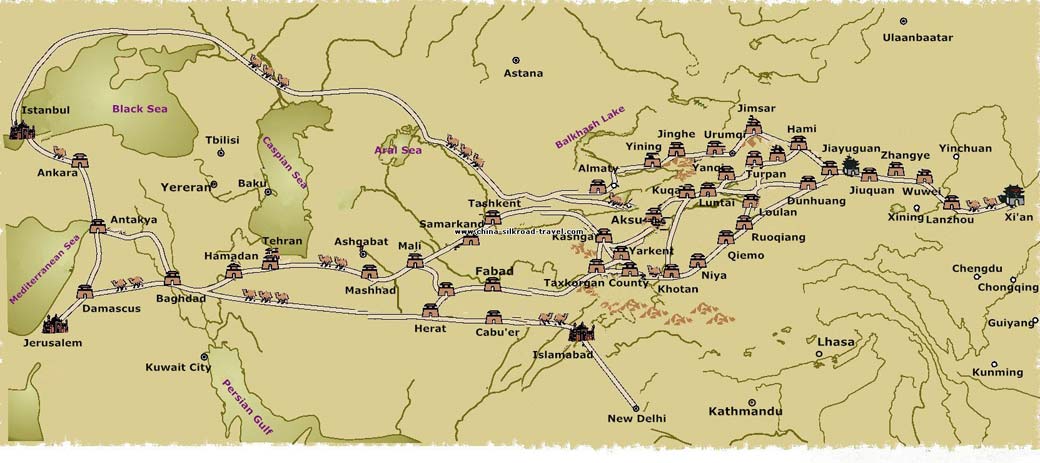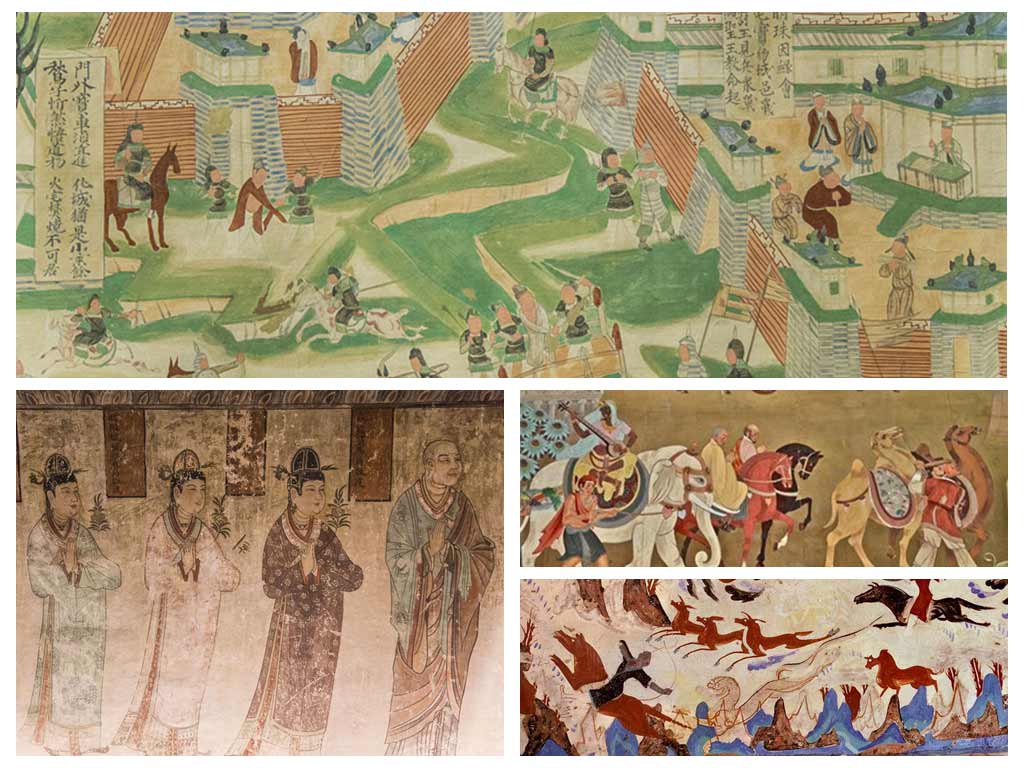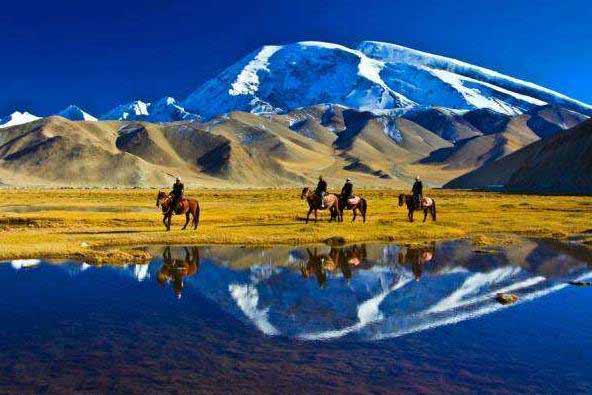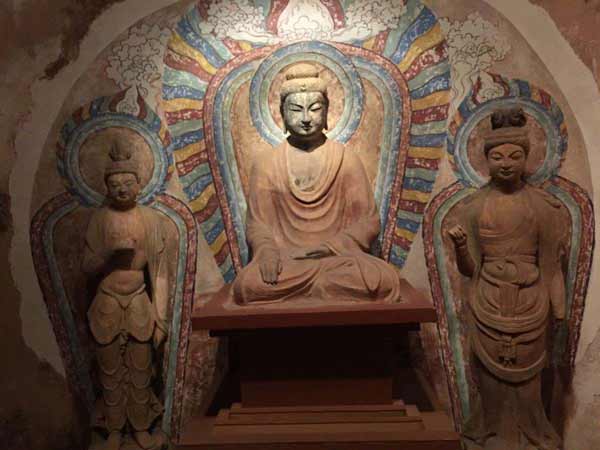Silk Road Guide
Back
The Opening of the Silk Road
Chinese silk was introduced to the outside world as early as during the 5th -6th century B.C. Archaeologists found scraps of Chinese silk in an old tomb dated 500B.C. At Stuttgart,Germany. By 400B.C.,Europeans began to learn about China through Chinese silk. In his historical work book on History and Geography,the Great historian Keta Pinchas referred to China as “Seres”,Meaning “a country of silk”. During a long period of time,due the long distance and inconvenience of communication,only a few silk products could be shipped to the West,making them extremely precious and valuable.
According to records,once the Roman Emperor Julius Caesar(102B.C.-44B.C.) wore a silk gown when he was watching an opera in the theater. When kings and ministers saw the dazzling silk gown,they couldn’t stop admiring it. The rarity of silk was only changed gradually after the opening of the world-renowned Silk Road.
During the late Warring States Period and the ensuing Qin and the Han dynasties,the northern frontier of the Central Plains Kingdoms were often subject to harassment by the northern nomadic Huns. Emperor Liu Bang,founder of the Ha Dynasty,was once besieged by the Hun cavalry at Mount Baideng where he almost lost his life. Since then,in order to seek peace of Central Plains,the Han rulers adopted a policy of pacification through marriage toward the Huns. They also sent all kind of precious presents such as silk and cotton to the Huns. In 140B.C., Emperor Wu of the Han Dynasty ascended the throne. After a period of recovery, national strength was greatly enhanced with social stability and economic prosperity prevailing in the country. The Han Dynasty ruler began to pursue a proactive foreign policy and set the goal to defeat the Huns in order to maintain peace and stability in the southern frontier. Having learned that Huns had killed the head of the Dayuezhi Kingdom in the Western Regions and forces its people to leave their land,Emperor Wu of the Han Dynasty planned to from an alliance with Dayuezhi to make pincer attach against the Huns.
In order to implement this plan,Emperor Wu dispatched Zhang Qian as his special envoy to the Western Regions in the 3rd year of the Jianyuan period(138B.C.) leading a contingent of more than one hundred men, Zhang Qian set of from Longxi(present-day southern of Lintao of Gansu) for Dayuezhi. He was unexpectedly detained by Huns on the way. Head of the Huns put Zhang Qian on exile the grassland of Mobei where he spent more than a decade. Alrough Zhang Qian eventually married A Huns girl and had children with her,he never forgot his errand. Finally he found an opportunity to escape from the Huns and continued his journey to the West. He passed the Dayuan and Kangqu kingdoms and finally arrived at Dayuezhi which had already settled down in the Amu River basin area. A s the Dayuezhi people were already leading a stable and peaceful life on this lush land,they didn’t want to launch wars against the Huns.
Having failed to lobby Dayuezhi into an alliance with Tang,Zhang Qian embarked on his return journey to his home country after one year. Unfortunately he was again detained by the Huns. A year later,civil unrest broke out in the Huns,Zhang Qian took the opportunity and escaped. In 126B.C., Zhang Qian returned to Chang’an,capital city of the Western Han Dynasty,thirteen years since he got on the mission. Of the more than one hundred men he led on the mission, only one returned with him. Zhang Qian reported to Emperor Wu the mission and that he saw ad heard in the western countries. The Emperor was immensely impressed by the rate and precious products of western countries that he decided to establish friendly ties with them.
In 119B.C. Zhang Qian was dispatched to the western regions on a second mission. Leading a contingent of more than three hundred men and bringing with them a large quantity gold,silk,cattle,and sheep,Zhang Qian first arrived in Wusu(present-day southeast of Lake Balkhash),an important hub in the Western Regions. Zhang Qian then sent his deputies to countries such as Dayuan,Kangqu(present-day southeast Kazakhstan),Daxia, Anxi(present-day northeast Iran), Shendu(ancient India) where they were warmly received. and they conducted large scale exchange of goods. In 115B.C. Zhang Qian returned to Chang’an. Dayuan,Anxi and some other western region countries sent envoys to travel together with the Han envoys.
Zhang Qian’s two missions to the Western Regions opened the East-West trans-Asia inland transportation routes. Between 104B.C. And 101B.C. Western Han set up four countries(juns)in the Western Regions:Jiuquan,Zhangye,Wuwei,and Dunhuang and formally incorporated the Western Regions into Western Han’s territory. This had also provided a safe and reliable channel for East-West cultural exchange. Since then, Han Dynasty envoys and merchants constantly to the Western Regions to carry out political and commercial activities. Similarly caravans from Western Regions traveled long distance to the Central Plains. A phenomenon featuring unprecedented East-West interaction and prosperity emerged. Large quantities of Chinese silk were shipped to Central Asia,West Asia and Europe through this transportation artery. In archaeological findings unearthed in recent years.large quantities of ancient Chinese Silk were found in the vast area between Chang’an in the East and the Mediterranean in the West,reflecting the prosperity of East-West trade in the ancient times.

The Development of Silk Road
The Han dynasty Silk Road (25-200) starts from Chang’an and divides into two route after passing the Hexi Corridor. The southern route goes westwards form the Yangguguan Pass located in the southwest of Dunhuang. It then follows the northern foot of the Kunlun Mountain, passing through Khotan, Shache and Puli (present-day Tashkurgan), crossing the Congling Ridges and reaches Dayuezhi. Further westwards the route reaches Anxi (present-day Iran) and Daqin(ancient Roman Empire) at Mediterranean; alternatively the route process southward form Dayuezhi to reach Shendu(ancient India). The northern route goes westwards from the Yumenguan pass located northwest of Dunhuang. Passing the former Cheshi Kingdom(present-day Turpan), it goes westwards along the southern foot of the Tianshan Mountain and reaches Dayuan after passing though the kingdom of Yanqi and Shule.
Silk Road enjoyed new development during the Three Kingdoms Period(220-280). It not only continued its extension west of the Congling Plateau, but also opened a new route along the northern foot of the Tianshan Mountain, thus increasing the Silk Road routes to three. During the Wei, Jin and Southern and Northern Dynasty periods(220-589), due to China’s long term division, the administration’s capacity in managing the Western Regions and operating the Silk Road was adversely affected. Fortunately the Silk Road was not interrupted during this period. Some aspects of the road even showed signs of prosperity. In particular, the eastwards dissemination Buddhism brought a large number of monks from India and central Asia to China, bring vigor and vitality to Chinese Buddhism and culture. The most famous was the master monk Kumarajiva(344-413). At the same time, Chinese Buddhist monks and scholars also traveled to the western Rgions to seek Buddhist Dharma. For instance in 399, monk Faxian traveled to ancient Indian via the Silk Road. In addition frequent wars and chaos inflicted upon the Central Plains area forced many Han Chinese to flee westwards along the Silk Road to avoid the fighting. This also accelerated the dissemination of Chinese culture to western Region.
The Sui and Tang Dynasty Period(581-907) witness the development and prosperity of socio-economy and culture after the termination of a long period of disunity. National strength was unprecedentedly powerful. The imperial court made the strengthening of contact and exchanges with western region countries and maintaining the smooth flow of the Silk Road one of the essential national policies. Emperor Yang of Sui Dynasty pursued a policy featured by conscientious operation of the Silk Road and close ties with countries in the Western Regions. In the 4th year of the Zhengguan Period(630) of Emperor Taizong’s region in the Tang Dynasty, Tang army defeated the eastern Turks regime that occupied part of the Silk Road formerly and strengthened friendly ties with Western Turks. Later the Tang army wiped out other separatist forces such as the Gaochang, Yanqi and Qiuci. In the 14th year of the Zhenguan period(640), the imperial court of the Tang Dynasty set up a military administration in the Western Regions to strengthen its governance of the western frontier and to ensure smooth operation and prosperity of the Silk Road. Shortly after, the Tang Dynasty government unified the Mobei region, hence strengthened the links between the Mobei region and the Central Plains, and opened up a communication channel between the western region and the northern frontier. At that time, in a addition to the trunk route, many sub-route of the Silk Road were also opened. This had further facilitated the north-south traffic. In the 3rd year of the Zhengguan Period(629) when Xuanzang, a master monk of the Tang Dynasty, traveled to ancient India to look for Buddhist Dharma, he passed through Gaochang, Yanqi, and Qiuci areas, which were all part of the Silk Road. He then crossed the Tianshan Mountain and entered the Indian subcontinent, an evidence of the existence of sub-routes of the Silk Road.
Silk weaving technology was greatly improved during the Tang Dynasty (618-907)with many varieties of silk products with fancy designs produced. Among them silk brocades with birds and flowers patterns were not only harmoniously laid out, but also had dazzling colors, representing the highest level of brocade production technology. Persian and Arab traders often shipped large quantities of Chinese silk to the Westerns Regions. The then Eastern Roman Empire was the largest importer of Chinese silk.
The Silk Road flourished in early year of Tang Dynasty when it entered a golden period of development. Yet by mid-Tang, with the increase of sea routes, more and more western merchants came to China by the sea way. Silk Road showed signs of decline. In the 14th year of the Tianbao Period(755) local military and administrative official An Lushan launched an armed rebellion.
The Tang army stationed on the four western frontier towns was called back to Chang’an to safeguard the capital. Taking this opportunity of unguarded northwest frontier, Tibetan troops in the south occupied the Helong area, and the Uygur in the north controlled the Altai area. By then the Tang Dynasty government lost control of western Regions. For the time being the Silk Road was “interrupted and inaccessible”.
The Decline of the Silk Road
During the Northern Song Dynasty(960-1127), the relatively weak Han regime ruling the Central Plains controlled only a limited area. Its trade with the Western Regions and foreign counties also suffered impediment. The Silk Road was not open. By the time of the Southern Song Dynasty, as a result of the vigorous support from the imperial court, coupled with advance in the shipbuilding technology, sea route became the major channel for china’s external communication and trade. Land route Silk Road was almost abandoned.
In the 13th century, the Mongol Empire in the northern grassland rose. Led by Genghis khan the Mongolian cavalry took three expeditions to the Western Regions and conquered vast areas of North Asia, Central Asia and West Asia. Having conquered kingdoms of West Xia, Jin and Southern Song, the Yuan rulers unified China and set up a well-developed post house system, which enable the Silk Road to flourish again. Emissaries, missionaries and merchants from European countries came to China by way of the silk road.
In the 24th year of the Hongwu period of emperor Taizu(1391), the Ming army captured Hami. In 1406, emperor Chengzu established an office in Hami to serve as base for implementing its economic policies in the Western Regions. The Ming government also established tributary relations with countries in the Western Regions. In 1472, the Mongolian Chagatai Khan led his army to attack and captured Hami. The Ming army was forced to retreat to Jiayuguan Pass, leaving the regions beyond the Jiayuguan Pass falling apart. Although local trade among civil society still went on along the Silk Road, the booming prosperity no longer existed. In the 15th century, with the Ottoman Empire’s occupation of Constantinople, capital city of the Eastern Roman Empire, land transportation in Europe and China become all the more difficult. Europeans had to explore new trading routes. With the advancement of shipbuilding and marine technology, more and more Europeans attempted to travel to the East by the sea. In 1498, a Portuguese navigator D.Gama discovered the Indian Ocean route, thus opened up a new route on the sea. Westerners coming to China via the sea route increased gradually. Since the 15th century, Silk Road gradually became a relic of China’s history of exchanges with foreign counties.

Top Silk Road Attractions




